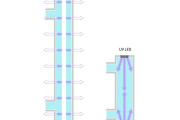Apart from lighting, LED backlight unit (BLU) applications are another driving force for the growth of LED market. The adoption of LED backlighting in medium and large-sized LCD panels has become more promising since Samsung first introduced the term “LED TV.”
LEDinside has recently interviewed Mr. Hart Pan, Senior Manager of Module LOB, Advanced Lighting Solution SBU, Lite-On Technology Corporation, to explore the challenges posed to the LED backlight technology and most popular LED backlit LCD TVs from a packager’s perspective.

LED NB market is already mature with potential to replace mainstream CCFL
In the past, LEDs had not bright enough for use in medium and large-sized monitors, and was thus restricted to BLU applications in small-sized portable monitors for mobiles. It is not until November 2005 when Sony launched VAIO Type TX series, the first LED backlit NB, that white light LED BLUs started to be applied into medium-sized panels. Given LED product enhancement, LEDinside estimates that LED backlit NB (including netbooks) penetration rate will reach up to 59.8% in 2009. Meanwhile, LED backlight modules will formally replace CCFL to become the mainstream NB backlight.
Lite-On is the largest white LED backlight supplier in Taiwan, with 25% market share in LED backlit NB market. Mr. Pan pointed out that current NB backlight has clearly trended from CCFLs to LED modules and manufacturers are beginning to target at next generation LED applications when the whole market gradually becomes more mature.

The cost of LED monitor runs high while heat dissipation of LED TV is the key
In comparison, it is more likely for TVs rather than monitors to adopt LED backlighting. However, price position plays a key role. In terms of TV products, although LED backlighting raises the cost, it also offers highly differentiated added value through slimmer design and energy saving attributes, bringing new product specialties to consumers. On the other hand, in cost analysis, TV panel only accounts for 60% of its production cost, and then accordingly the actual cost increase from LED backlighting will be diluted. In contrast, panel prices take up 80% of the total cost of mature monitor products. Besides, consumers are highly sensitive to IT product prices. LED backlit monitors may not be widely adopted as expected unless a new solution emerges to reduce both the number of LEDs and their cost.
On a technical level, more LEDs are required as the LCD panel size increases. As a result, heat dissipation becomes a great challenge to the adoption of LED backlight in the large-sized panel. LED NB backlight uses around 40-64 low-power LEDs, so there is no need for a special heat dissipation device since overall energy consumption is rather low. However, in an LED backlit TV, both the number of LEDs and their energy consumption are almost a hundred times that of LED backlit NBs, therefore it is necessary to set up an independent heat dissipation system to prevent LEDs from overheating and affecting their lifetime and picture quality. At this stage, LED chips and PCB materials must be improved. Low temperature and high brightness LEDs will be critical for future development of the LED TV market.
Package design optimization and save production cost
From Lite-On’s perspective as a packager, due to various chip sizes and considerations involved in product design, there is no uniform package standard for TV LEDs, but double chip package and triple chip package are more common. With the increasing popularity of Samsung LED TVs, the number of LEDs or package modules has drawn much attention. However, industry players should also pay attention to power rating (luminous flux per watt) and cost saving attributes in package design optimization, added Mr. Pan.

The light guide makes the difference
In light of LED backlight types for TV panels, the two Korean manufacturers have secretly kicked off a technology competition. Samsung has launched a side light type LED TV with 6 light bars around the panel as well as improved picture quality by its proprietary technology; meanwhile, LG’s TV adopts direct light type backlight along with local dimming technology to achieve high-contrast effect, but the cost is relatively higher than the former. In fact, each technology has its own strengths and weaknesses. It is hard to tell in the short term which one will dominate the market, but the light guide is definitely the key to success.
Insights from LEDinside
Despite the bright outlook of LED backlighting, there is still room for improvement for the LED light source, including luminosity, brightness and homogeneousness. One thing to be noted, LED is point light source, thus unlike linear light source CCFL, LED backlight for TV panels needs special treatment of homogeneous illumination, which increases their production costs. Therefore, technology advancement is essential for LED backlight to take the place of CCFL in the near term.
According LEDinside, after upstream chipmakers scales up production in the latter half of 2010, the drop in LED chip prices will in turn facilitate brand vendors in the introduction of LED backlight. However, brand makers and LED makers take different stances on its application – take monitors for example, to LED makers, LED backlight is recognized for its energy saving attributes, but brand makers regard it as product segmentation in marketing, and are therefore highly optimistic about the introduction of LED backlight into monitors in 2010.
If the bottleneck of LED chip supply is relieved next year, the LED monitors and LED TVs may be able to mirror the success of LED backlit NB, and lead their respective market growth. LEDinside predicts that even though global market penetration rate of LED TVs will be around 3% in 2009, this figure is expected to climb up to 17% in 2010.





 CN
TW
EN
CN
TW
EN








